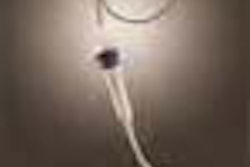SAN FRANCISCO - Given that postmenopausal vaginal bleeding is a common clinical problem, endovaginal ultrasound presents an attractive noninvasive option for evaluating afflicted patients. But can the results be routinely relied upon without a follow-up endometrial biopsy in clinical practice?
Radiologists from the Virginia Mason Medical Center in Seattle asked the question as the first step in developing a clinical pathway for evaluation of postmenopausal bleeding at their institution. Dr. Alexi J. Phinney presented the results of a retrospective study of 327 women at this week's American Institute of Ultrasound in Medicine conference in San Francisco.
"We were interested in how often EVUS could replace endometrial biopsy in our patients," Phinney said.
Several earlier studies have found EVUS to be highly sensitive for detecting endometrial cancer and other endometrial disease (JAMA 1998 Nov 4;280(17):1510-7). Using the 5-mm threshold that has been established to define abnormal endometrial thickening, the Seattle researchers sought to determine what percentage of their postmenopausal patients presented with endometrial thickness of 5 mm or less.
The researchers retrospectively reviewed all endovaginal ultrasound and biopsy pathology reports over a 54-week period on women over 45 years old who presented with "vaginal symptoms that warranted further examination," Phinney said, mostly bleeding. Whether or not patients had undergone hormone replacement therapy was not a factor in patient selection, he said, although many patients were included because bleeding normally associated with HRT continued beyond the expected six months, he said.
The endometrial thickness measurement was usually taken from the endovaginal ultrasound exam required for study participation, but the readers were also permitted to use the results of routine transabdominal pelvic imaging for this measurement when they felt it was more reliable. The results were read by radiologists and sonographers with a wide range of experience (0-18 years), which probably reflects the range of most large practices, Phinney said. Out of 327 patients examined sonographically, 187 underwent correlative endometrial biopsy within six weeks of the ultrasound.
Out of 327 patients, "nearly half (156/48%) had endometrial thickness of 5 mm or less," Phinney said. One hundred twenty patients (37%) had an endometrial thickness of 4 mm or less. "No patient with a stripe thickness of 5 mm or less had serious pathology," Phinney said. "Of those who did not have a correlative biopsy with us, none has been diagnosed with endometrial cancer." However, the endometrium could not be fully evaluated because of fibroids or other imaging difficulties in 7% of the patients, nearly twice the rate found in an earlier meta-analysis (Ultrasound Obstet Gynecol 1998 Oct; 12(4): 265-70). Phinney said about one-third of the endometrial biopsies were inconclusive as well.
Also, "The incidence of cancer in our study group was relatively low (at 1.8%) compared to published data, which are generally at about 10%," Phinney said. He attributed this to the study group's low pretest probability of cancer and high number of patients on HRT, as well as the clinic's overall emphasis on preventive care. However, an audience member later cautioned that looking only for focal endometrial cancer might not yield the same results as a global pelvic examination.
"In conclusion," Phinney said, "we have shown that in our relatively low-risk population, endovaginal ultrasound may be able to replace endometric biopsy in nearly half of those postmenopausal patients."
By Eric Barnes
AuntMinnie.com staff writer
April 5, 2000
Let AuntMinnie.com know what you think about this story.
Copyright © 2000 AuntMinnie.com

















